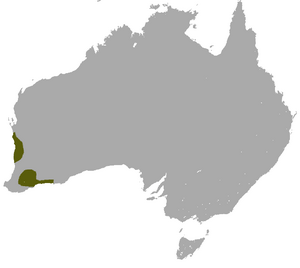White-tailed dunnart facts for kids
Quick facts for kids White-tailed dunnart |
|
|---|---|
| Conservation status | |
| Scientific classification | |
 |
|
| White-tailed dunnart range |
The white-tailed dunnart (Sminthopsis granulipes), also known as the ash-grey dunnart, is a dunnart native to Australia.
Contents
Taxonomy
A species first named by Gerard Krefft in 1872, using a specimen obtained at Albany by the local collector George Maxwell. The author assigned the name Podabrus albocaudatus with a description that was published in an Eastern States newspaper, the Sydney Mail. The same specimen, the holotype of the species, was described by Ellis Troughton in 1932 without reference to Krefft's earlier description. Despite the precedence of Krefft's first description, later recognised as a valid and available name, the later name was in widespread use and conserved to ensure taxonomic stability; the name Podabrus albocaudatus was deemed to be an objective synonym and declared a nomen oblitum and Sminthopsis granulipes Troughton 1932 a nomen protectum.
Description
A species of Sminthopsis with a head and body length from 70 to 100 mm, a tail measurement of 56–68 mm and a weight which varies from 18 to 35 grams. The upperparts of the pelage are uniform in colour, a lighter shade of fawn that merges with the white ventral side. The feet and tail are pinkish white. They are distinguished by the relative tail length, which is less than body, and its greater width at the base; a fine brown stripe occurs at the top of the tail. The soles of the feet at the hind-legs of S, granulipes are mostly covered in a uniform granular texture.
Distribution and habitat
This dasyurid occupies two separate areas in Western Australia. The first is east of Perth in the western Goldfields area and the second is to the north of Perth between Kalbarri and Jurien Bay. Habitat consists of coastal heath and sparse to dense shrublands sometimes with mallee eucalypt.
Social organisation and breeding
Little is known of the behaviour and breeding of this marsupial, though it is most likely nocturnal. It breeds from June through August with young weaned by October.
Diet
The white-tailed dunnart mainly eats terrestrial insects.
- Groves, Colin (16 November 2005). Wilson, D. E., and Reeder, D. M. (eds). ed. Mammal Species of the World (3rd edition ed.). Johns Hopkins University Press. pp. 34. ISBN 0-801-88221-4. http://www.bucknell.edu/msw3.
See also
 In Spanish: Ratón marsupial de cola blanca para niños
In Spanish: Ratón marsupial de cola blanca para niños


